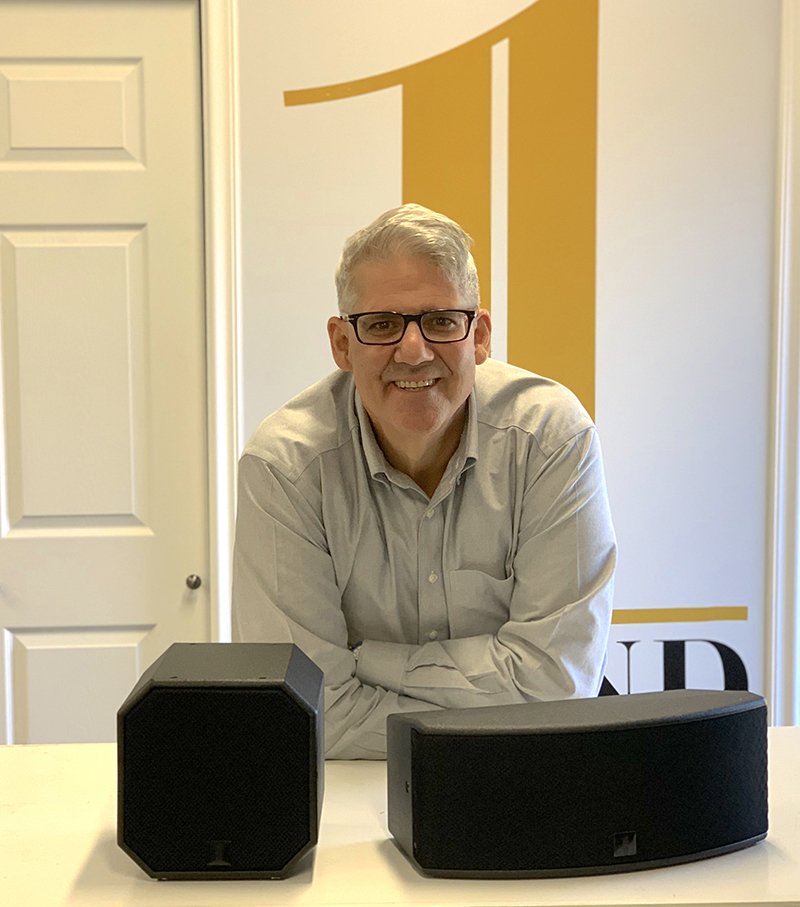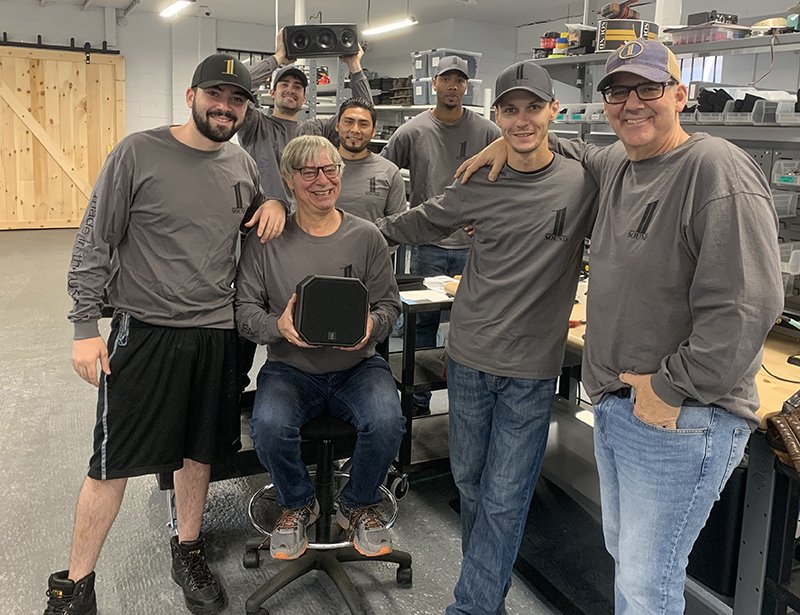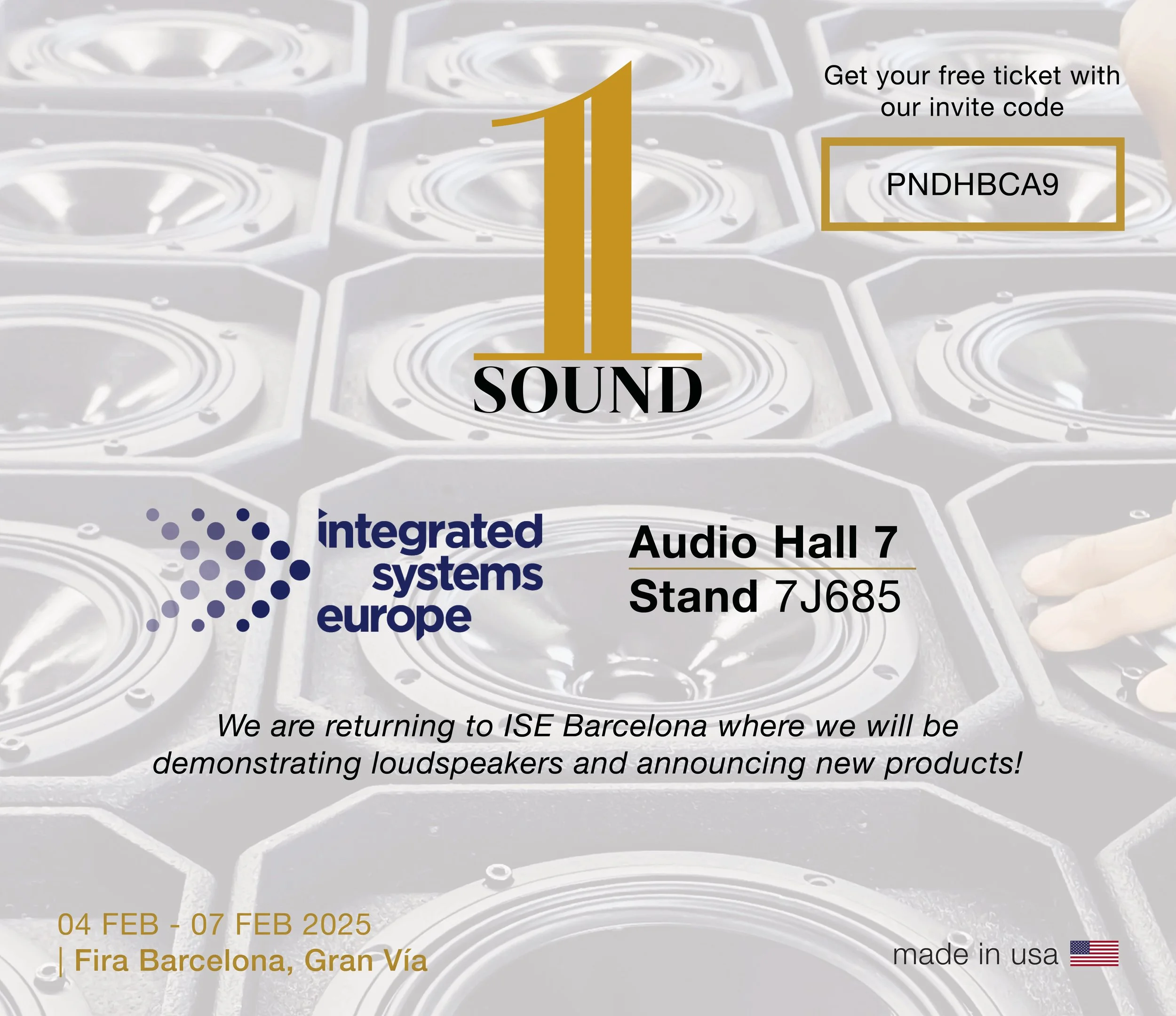The below Article is courtesy of www.fohonline.com.
Longtime Engineer Lou Mannarino Launches New “Made in America” Line of Speakers
Company founder Lou Mannarino with the C6 full-range coaxial and the MS34 stereo-mono speaker.
Many FRONT of HOUSE readers have heard of New York-based Lou Mannarino — musician, teacher, audio engineer and technical design producer. He’s also known for the top artists he’s engineered through the last 30 years, including Paul McCartney, Wynton Marsalis, Blondie, Bon Jovi, Josh Groban, John Legend, Tony Bennett and Yo Yo Ma. And he has also gained renown for his extensive theater and classical music work — including the New York Philharmonic. Then there’s his live event company, L&M Sound & Light, now approaching its fourth decade.
Enter 1 Sound
But now, Mannarino wants you to know him by his newest company: 1-Sound, a speaker manufacturing company. Now that’s gutsy enough; but he’s also committed to the products being built here in the U.S.
The company debuted at InfoComm 2019 as “a new company formed by industry vets with some new ideas.” They showed up with just five products, and the products weren’t very big (“no line arrays”), but they turned heads, particularly the MS34 mono + stereo speaker. This one-box, two-channel point source unit has a mono speaker flanked by stereo speakers, with an M-S stereo or line source mode select to determine the width of the image. This was designed for front fill, under-balcony, restaurants, public spaces, etc. The company also showed 5” and 6.5” coaxial speakers and two compact subs: a FSUB45 with four 5” woofers and the CSUB-210 dual-10 design with cardioid switching capability.
“We’re building this company from the ground up, and doing it with as many American suppliers as possible, with the complete assembling happening right here in our Staten Island building,” Mannarino says. “We’re making products to complement, not copy, what already exists in our strong industry.”
Classic Background, but Classically Trained
Mannarino grew up in the same Staten Island neighborhood where his current facility is located. In grade school, he played string bass, and then a little later, electric bass. “Then, in eighth grade, I got really excited about microphones — I still am,” he says. The purchase of his first sound system ensued. It was a TAPCO 6-channel mixer with a pair of those heavily padded Kustom P.A. speakers popular in the day. As he played bass in musical theater shows in high school, he got more interested in audio. In ninth grade, he put five mics on the stage that were able to pick it all up and push it through his P.A. “Right away, I was renting to five theaters, and there my dad was, driving me and my equipment around in his old station wagon.” By the time he was 16, he was earning around $15,000 a year which, in the early 1970s, was darn good money.
“There weren’t really any full-service production companies at the time,” he explains. “You would hire a sound engineer, then rent the audio gear from a different place, etc. If it didn’t work, everybody had someone else to blame.” By the time he was 18, L&M Sound & Light was a full-service shop that did it all. “If you weren’t happy, you didn’t have to pay us. Soon, every week of the year had us booked up with events.” While it’s not uncommon for a musician to get into performing’s side door, pro audio, Mannarino’s career path is unusual because he went on to pursue a formal music education during all this, accumulating three degrees including one in conducting. “That’s why I believe I’m with the New York Philharmonic — I can read the score while I’m mixing.”
Through building up his company over the years, he’s been an integral part of all: Mixing, project managing, running the company — and also welding, rigging, and handling stagehand duties. All of it influences his approach to work. “I speak from the musician’s perspective and the audience’s viewpoint, and from that, I work to create a symbiotic experience for all including designers and manufacturers. With talent and relationships that have been continuously developed over the years through L&M Sound & Lights, there’s a lot that has been learned…Now most of that learning was from making mistakes,” he adds, with a laugh.
Working with manufacturers has always been part of his company’s success, and he’s understandably proud of his collaborations. Over the years he has worked with L-Acoustics, K-array, E-V and Sennheiser, among others. As he got older, creating and building products here in the U.S. became important to him. Of the international pro-audio market, 50 percent of the products are bought and used here in the States. “If a company’s worldwide gross is $10 million, it could be that $5 million of its sales happen here. I don’t think a lot of people in our industry realize the U.S. economic power. If a product becomes popular in the U.S., then it becomes popular elsewhere.” Because of all that, he felt like foreign companies should try to put an assembly factory here. His pitch went unheeded. His solution was to start 1-Sound.
Necessary Tools
This is clearly not something he needed to do. “Everybody has great equipment, so it wasn’t about that,” Mannarino says. “It’s simply an opportunity because I’m still passionate about designing audio. I have two sons in their 20s, and this is for them too — an opportunity to teach them. I’m motivated.” The search for U.S.-based suppliers has been an unexpected joy for him. “We just got a delivery today on a new sound-absorption material, different from what other manufacturers may be using. So, I found a company in Pennsylvania making something that’s lighter and better that does exactly what we need.” Mannarino says while some colleagues were concerned that all his ideas have already been given to other audio manufacturers, he was not worried. “The launching of this new company is the idea to create products that aren’t being made that we felt should be in the toolbox of engineers, designers, and integrators.”
The MS34 features an unusual idea: M+S technology, which is mono surrounded by the width of stereo. “I’ve been working for years on a single mono near-field fill speaker that also allowed [the listener] to hear the depth of a singer with reverb. It had to be analog, and for me, it’s a game changer.” It’s flexible too, as it can be used as a stand-alone mono loudspeaker (switch and preset dependent), but also become a horizontal line source helping to preserve its off-axis frequency response while adding an additional 4 dB of gain. As noted, this speaker made its debut with much fanfare at InfoComm 2019, and it’s shipping now. “We had an incredible reaction that really took us by surprise,” Mannarino says. “People who heard it sent others to check it out. Other designers and company owners I admire came to check it out.”
Then there are the Cannons, which Mannarino built shooting for the most natural sound with the greatest response. The C5 and C6 features a passive 5” coaxial with a 5” passive radiator and a passive 6.5” coaxial with a 5” passive radiator respectively, and they are built to be high-definition loudspeakers with extended low frequency response. “I can compare everything I do with microphones. So often it’s not what it picks up, but what it doesn’t pick up.” The FSUB45 is a passive, lightweight fast-responding subwoofer that is remarkably compact and built for those hard-to-reach places. “It’s light, at 30 pounds, and there’s no rigging, no holes, no branding — you only need a floor.” The larger CSUB210, which weighs in at 60 pounds, is something that you can turn perpendicular or keep it sideways. Either way, there are three polar patterns that can be used: cardioid at 65 Hz, sub cardioid [end-fire] at 65 Hz, and omnidirectional at 65 Hz. “I created the full cardioid one because I am doing work at the Metropolitan Museum, and they needed to keep the subwoofer away from the art,” Mannarino notes.
The amps (T302, T304, T602, T604) are from a partnership with Powersoft. “Our MS speakers have analog circuitry and can’t be used with any everyday amplifier, so we worked with Powersoft and are distributing their new touring line of amps. In addition to having analog capacity, the T Series include AES3 and Dante inputs.” Mannarino adds that the fact that they have a full-staffed office across the bridge in Newark fits with the general philosophy of the company of “keeping it local.”
Having spent three decades on the “other side” (“I’ve purchased equipment every year for 40 years”), Mannarino sees a big benefit for those who do work with U.S. based/built companies. “When a customer orders 100 of these speakers, and two of them have a problem, we’re right there on the phone when you call, and you get replacements immediately. No waiting for the next shipment from China. Also, manufacturing here allows for custom products.”
1 SOUND Team












